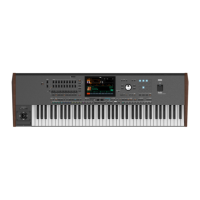358| MicrophoneInput
The two Low and High EQ bands boost or cut all frequencies below or above the
frequencies set by the Frequency (Hz) controls. They can be set either as Bell- or
Shelving-shaped curves by using the Bell buttons.
EQ Shape Meaning
BellOn(Bell) Bell-shapecurve,allowingfordetailedcorrectionofaspecicrange
offrequencies.TheselectedfrequencyisatthecenteroftheEQ
band.
BellO(LowShelving) Low-Shelvingcurve,allowingforsmoothlycuttingorboostingthe
lowestfrequencies.Thiswillletyouaddmorebodytothesound
(boost),orremoveboomyfrequencies(cut).
BellO(HighShelving) High-shelvingcurve,allowingforsmoothlycuttingorboostingthe
highestfrequencies.Thiscanhelpadding‘air’(boost),orremove
sibilance(cut).
The Mid Parametric EQ boosts or cuts the frequencies within a selected band,
that is dened by a center frequency selected with the Frequency (Hz) knob, and
a width selected with the Q knob (the ‘Quality’ control).
The three Gain (dB) controls allow +/-18 dB of adjustment. The three Frequency
(Hz) controls range from 20 Hz to 20 kHz.
Programming the Compressor
Use the Compressor to reduce the range between louder and softer singing to
produce more even-sounding vocals.
We typically sing dynamically, like this (capitals are used to show louder dynam-
ics):
I LOVE to watch you WALK down the STREET
At acoustic singing levels with no, or very quiet instrumentation, this would sound
ne. When amplied, however, the loud words become strident and even worse,
quiet words can be lost in the instrument sounds. The louder the amplication sys-
tem and band the more pronounced the loud parts become. Compression seeks
to do the following to your dynamics:
I LOVE to watch you WALK down the STREET

